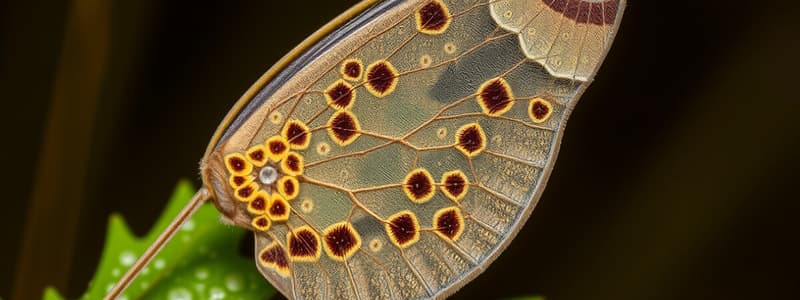Podcast
Questions and Answers
List the 3 dispersal patterns seen in nature.
List the 3 dispersal patterns seen in nature.
- Random dispersion 2) Clumped dispersion 3) Uniform dispersion
Which pattern in nature is the least frequent?
Which pattern in nature is the least frequent?
Random dispersion
Which pattern in nature is most frequent?
Which pattern in nature is most frequent?
Clumped dispersion
List 4 factors that often influence clumped dispersion.
List 4 factors that often influence clumped dispersion.
List in order the hierarchical organization within ecology: population -> ___ -> ecosystem -> ___
List in order the hierarchical organization within ecology: population -> ___ -> ecosystem -> ___
Which of the above does natural selection act most directly on?
Which of the above does natural selection act most directly on?
List 2 examples of density-dependent factors that influence the size of a population.
List 2 examples of density-dependent factors that influence the size of a population.
Define intraspecific scramble competition.
Define intraspecific scramble competition.
Is scrambled competition good?
Is scrambled competition good?
What does scrambled competition make the population susceptible to?
What does scrambled competition make the population susceptible to?
Give an example of scrambled competition.
Give an example of scrambled competition.
Distinguish between abiotic and biotic factors.
Distinguish between abiotic and biotic factors.
Distinguish between r and k selected organisms. Give an example of each.
Distinguish between r and k selected organisms. Give an example of each.
Define age structure.
Define age structure.
What happens to a population that has a high proportion of prereproductive individuals?
What happens to a population that has a high proportion of prereproductive individuals?
A human population that is shrinking would have a small proportion of _______ individuals.
A human population that is shrinking would have a small proportion of _______ individuals.
The world population has increased dramatically during the past few centuries due to what?
The world population has increased dramatically during the past few centuries due to what?
How many species must be present to make up a community?
How many species must be present to make up a community?
A community is made up of biotic and abiotic parts.
A community is made up of biotic and abiotic parts.
An ecosystem is made up of biotic and abiotic parts.
An ecosystem is made up of biotic and abiotic parts.
What is the function of producers, consumers, and decomposers in a community? Must we have all three?
What is the function of producers, consumers, and decomposers in a community? Must we have all three?
Name 3 characteristics of a community.
Name 3 characteristics of a community.
Flashcards are hidden until you start studying
Study Notes
Dispersal Patterns in Nature
- Random dispersion occurs when individuals are spaced without regard to others, often seen in species with no specific resource needs.
- Clumped dispersion, the most common pattern, is due to uneven resource distribution and social structures within species.
- Uniform dispersion results in evenly spaced individuals, often resulting from competition for resources.
Ecological Hierarchical Organization
- Population is the smallest organization, followed by community, then ecosystem, and finally biosphere.
Natural Selection Influence
- Natural selection primarily acts on populations, shaping traits and behaviors that enhance survival and reproduction.
Density-Dependent Factors
- Predation, disease, and competition are examples of factors that limit population size and reflect interdependence among species.
Intraspecific Scramble Competition
- Exploitation competition occurs when individuals share limited resources equally, leading to inadequate resources and potential population declines.
Effects of Scrambled Competition
- High population density can result in starvation and significant population drops, illustrated by the moose crisis on Isle Royale.
Abiotic vs. Biotic Factors
- Abiotic factors refer to nonliving elements, like temperature and soil, affecting organisms; biotic factors are the living influences, such as predators and prey.
r and K Selected Organisms
- r-selected species, like insects, prioritize rapid reproduction, while K-selected species, such as redwoods, focus on survival in stable environments with fewer offspring.
Age Structure and Population Growth
- High proportions of prereproductive individuals indicate strong potential for population growth, as they contribute to larger future generations.
Human Population Dynamics
- The dramatic rise in global population is attributed to younger age structures and fertility rates above the replacement level.
Community Composition
- The size and species number within a community can vary greatly, and communities consist only of biotic factors.
Ecosystem Composition
- Ecosystems include both biotic (living) and abiotic (nonliving) components, which interact to sustain life.
Roles in a Community
- Producers (photosynthetic organisms), consumers (herbivores, carnivores), and decomposers (fungi, bacteria) create a balanced ecosystem, all three roles are essential.
Community Characteristics
- Communities have diverse characteristics, including species richness, relative abundance, interspecies interactions, resilience to disturbances, nutrient flow, and productivity.
Fundamental vs. Realized Niche
- The fundamental niche encompasses the ideal conditions a species can occupy, while the realized niche is the actual space a species occupies due to competition and other limiting factors.
Studying That Suits You
Use AI to generate personalized quizzes and flashcards to suit your learning preferences.




